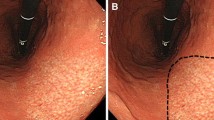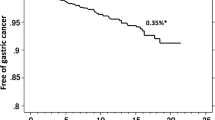Abstract
The histopathological changes due to chronicHelicobacter pylori infection are well characterized. Nevertheless, the clinical and pathological outcomes resulting from the cure of this infection remain incompletely described. In particular, the influence of eradication ofH. pylori on nonulcer dyspepsia, the long-term effects ofH. pylori eradication on gastric atrophy and intestinal metaplasia, and the role ofH. pylori eradication in the prevention of gastric cancer are still unclear. We reviewed 38 studies reported between 1993 and 1999 on the outcome of various disorders related toH. pylori infection after successful eradication. There is general agreement concerning the regression of chronic gastritis, lymphoid follicles, and limited-stage lowigrade MALT lymphomas of the gastric mucosa after eradication ofH. pylori infection. Conversely, there are still major questions on whetherH. pylori eradication improves the outcome of premalignant lesions, such as atrophy, intestinal metaplasia, and dysplasia. Finally, some extragastric idiopathic diseases seem to improve in consequence of the eradication of the infection, although there are still no definitive data to support this.
Similar content being viewed by others
References
Marshall BJ, Warren JR. Unidentified curved bacilli in the stomach of patients with gastritis and peptic ulceration. Lancet 1984;1:1311–5.
Marshall BJ, Armstrong JA, McGechie DB, Glancy RJ. Attempt to fulfil Koch’s postulates forCampylobacter pyloris. Med J Aust 1985;142:436–9.
Isaacson PG. Mucosa-associated lymphoid tissue lymphoma. Semin Hematol 1999;36:139–47.
Eslick GD, Lim LL, Byles JE, Xia HH, Talley NJ. Association ofHelicobacter pylori infection with gastric carcinoma: a metaanalysis. Am J Gastroenterol 1999;94:2373–9.
Gasbarrini A, Franceschi F, Armuzzi A, Ojetti V, Candelli M, Torre ES, et al. Extradigestive manifestations ofHelicobacter pylori gastric infection. Gut 1999;45(suppl 1):19–112.
Dixon M. Pathological consequences ofHelicobacter pylori infection. Scand J Gastroenterol Supp 1 1996;215:21.
Genta RM, Lew GM, Graham DY. Changes in the gastric mucosa following eradication ofHelicobacter pylori. Mod Pathol 1993;6:281–9.
Witteman EM, Mravunac M, Becx MJ, Hopman WP, Verschoor JS, Tytgat GN, et al. Improvement of gastric inflammation and resolution of epithelial damage one year after eradication ofHelicobacter pylori. J Clin Pathol 1995;48:250–6.
Van Der Hulst RWM, Van Der Ende A, Dekker FW, Ten Kate FJ, Weel JF, Keller JJ, et al. Effect ofHelicobacter pylori eradication on gastritis in relation to cagA: a prospective 1-year follow-up study. Gastroenterology 1997;113:25–30.
Tepes B, Kavcic B, Zaletel LK, Gubina M, Ihan A, Poljak M, et al. Two-to four-year histological follow-up of gastric mucosa afterHelicobacter pylori eradication. J Pathol 1999;188:24–29.
Negrini R, Savio A, Poiesi C, Appelmelk BJ, Buffoli F, Paterlini A, et al. Antigenic mimicry betweenH. pylori and gastric mucosa in the pathogenesis of body atrophic gastritis. Gastroenterology 1996;111:655–65.
Kato S, Furuyama N, Ozawa K, Ohnuma K, Iinuma K. Long-term follow-up study of serum immunoglobulin G and immunoglobulin A antibodies afterHelicobacter pylori eradication. Pediatrics 1999;104:e22.
Graham DY, Dixon MF. Acid secretion,Helicobacter pylori infection and peptic ulcer disease. In: Graham DY, Genta RM, Dixon MF, editors. Gastritis. Philadelphia: Lippincott Williams & Wilkins, 1999. p. 177–87.
Figura N.Helicobacter pylori exotoxins and gastroduodenal diseases associated with cytotoxic strain infection. Aliment Pharmacol Ther 1996;10(suppl 1):79–96.
Yamaoka Y, Kita M, Kodama T, Sawai N, Imanishi J.Helicobacter pylori cagA gene expression of cytokine messenger RNA in gastric mucosa. Gastroenterology 1996;110:1744–52.
Crabtree JE. Role of cytokines in pathogenesis ofHelicobacter pylori-inductd mucosal damage. Did Dis Sci 1998;43(suppl 9): 46S-55S.
Blaser MJ. Heterogeneity ofHelicobacter pylori. Eur J Gastroenterol Hepatol 1997;9(suppl l):S3–7.
NIH Consensus Conference.Helicobacter pylori in peptic ulcer disease: NIH consensus development panel onHelicobacter pylori in peptic ulcer disease. JAMA 1994;272:65-9.
Goggin N, Rowland M, Imrie C, Walsh D, Clyne M, Drumm B. Effect ofHelicobacter pylori eradication on the natural history of duodenal ulcer disease. Arch Dis Child 1998;79:502–5.
Chan KL, Tarn PK, Saing H. Long-term follow-up of childood duodenal ulcers. J Pediatr Surg 1997;32:1609–11.
Goh KL, Navaratnam P, Peh SC. Reinfection and duodenal ulcer relapse is south-east Asian patients following successfulHelicobacter pylori eradication: results of a 2-year follow-up. Eur J Gastroenterol Hepatol 1996;8:1157–60.
Pilotto A, Franceschi M, Di Mario F, Leandro G, Bozzola L, Valerio G. The long-term outcome of elderly patients withHelicobacter pylori-associated peptic ulcer disease. Gerontology 1998;44:153–8.
Van Der Hulst RW, Rauws EA, Koycu B, Keller JJ, Bruno MJ, Tijssen JG, et al. Prevention of ulcer recurrence after eradication ofHelicobacter pylori: a prospective long-term follow-up study. Gastroenterology 1997;113:1082–6.
Forbes GM, Glaser ME, Cullen DJ, Warren JR, Christiansen KJ, Marshall BJ, et al. Duodenal ulcer treated withHelicobacter pylori eradication: seven-year follow-up. Lancet 1994;343:258–60.
Kuipers EJ, Uyterlinde AM, Pena AS, Roosendaal R, Pals G, Nelis GF, et al. Long-term sequelae ofHelicobacter pylori gastritis. Lancet 1995;345:1525–8.
Oberhuber G, Wuendisch T, Rappel S, Stolte M. Significant improvement of atrophy after eradiation therapy in atrophic body gastritis. Pathol Res Pract 1998;194:609–13.
Tucci A, Poli L, Tosetti C, Biasco G, Grigioni W, Varoli O, et al. Reversal of fundic atrophy after eradication ofHelicobacter pylori. Am J Gastroenterol 1998;93:1425–31.
Satoh K, Kimura K, Takimoto T, Kihira K. A follow-up study of atrophic gastritis and intestinal metaplasia after eradication ofHelicobacter pylori. Helicobacter 1998;3:236–40.
Forbes GM, Warren JR, Glaser ME, Cullen DJ, Marshall BJ, Collins BJ. Long-term follow-up of gastric histology afterHelicobacter pylori eradication. J Gastroenterol Hepatol 1996;11:670–3.
Correa P.Helicobacter pylori as pathogen and carcinogen. J Physiol Pharmacol 1997;48(suppl 4):19–24.
Honda S, Fujioka T, Tokieda M, Satoh R, Nishizono A, Nasu M. Development ofHelicobacter pylori-induced gastric carcinoma in mongolian gerbils. Cancer Res 1998;58:4255–9.
Farinati F, Foschia F, Di Mario F, Cassaro M, Rugge M.H. pylori eradication and gastric precancerous lesions. Gastroenterology 1998;115:512–13.
Uemura N, Mukai T, Okamoto S, Yamaguchi S, Mashiba H, Taniyama K, et al. Effect ofHelicobacter pylori eradication on subsequent development of cancer after endoscopic resection of early gastric cancer. Cancer Epidemiol Biomarkers Prev 1997;8:636–42.
Isaackson PG, Norton AJ, Mucosa-associated lymphoid tissue (MALT) and the MALT lymphoma concept. In: Isaackson PG, Norton AJ, editors. Extranodal lymphomas. Edinburgh: Churchill Livingstone, 1994. p. 5–14.
Genta RM, Hamner HW, Graham DY. Gastric lymphoid follicles inHelicobacter pylori infection. Hum Pathol 1993;24:577–83.
Tursi A, Cammarota G, Papa A, Cuoco L, Fedeli G, Gasbarrini G. Long-term follow-up of disappearance of gastric mucosaassociated lymphoid tissue afteranti-Helicobacter pylori therapy. Am J Gastroenterol 1997;92:1849–52.
Wotherspoon AC, Doglioni C, Diss TC, Pan L, Moschini A, De Boni M, et al. Regression of primary low-grade B-cell gastric lymphoma of mucosa-associated lymphoid tissue type after eradication ofHelicobacter pylori. Lancet 1993;342:575–7.
Bayerdorffer E, Neubauer A, Rudolph B, Tiede C, Lehn N, Eidt S, et al. Regression of primary gastric lymphoma of mucosaassociated lymphoid tissue type after cure ofHelicobacter pylori infection. Lancet 1995;345:1591–4.
Wotherspoon A, Ortiz-Hidalgo C, Falzon MR, Isaacson PG.Helicobacter pylori-associated gastritis and primary B-cell gastric lymphoma. Lancet 1991;338:1175–6.
Alkan S, Karcher DS, Newman MA, Cohen P. Regression of salivary MALT lymphoma after treatment forHelicobacter pylori. Lancet 1996;348:268–9.
Fishbach W, Tacke W, Greiner A, Konrad H, Muller H. Regression of immunoproliferative small intestinal disease after eradication ofHelicobacter pylori. Lancet 1997;349:31–2.
Matsumoto T, Iida M, Shimizu M. Regression of mucosa-associated lymphoid-tissue lymphoma of rectum after eradication ofHelicobacter pylori. Lancet 1997;350:115–6.
Gasbarrini A, Franceschi F, Gasbarrini G, Pola P. Extradigestive diseases andHelicobacter pylori infection. Eur J Gastroenterol Hepatol 1997;9:231–3.
Gasbarrini A, Massari I, Serricchio M, Tondi P, De Luca A, Franceschi F, et al.Helicobacter pylori eradication ameliorates primary Raynaud’s phenomenon. Dig Dis Sci 1998;43:1641–5.
Gasbarrini A, De Luca A, Fiore G, Gambrielli M, Franceschi F, Ojetti V, et al. Beneficial effects ofHelicobacter pylori eradication on migraine. Hepatogastroenterology 1998;21:765–70.
Reinauer S, Megahed M, Goerz G, Ruzicka T, Borchard F, Susanto F, et al. Schonlein-Henoch purpura associated with gastricHelicobacter pylori infection. J Am Acad Dermatol 1995;33:876–9.
Sorrentino D, Ferraccioli GF, Devita S, Labombarda A, Avellini C, Ponzetto A, et al. Gastric B-cell clonal expansion andHelicobacter pylori infection in patients with autoimmune diseases and with dyspepsia. A follow-up study. Scand J Gastroenterol 1997;32:1204–8.
Gasbarrini A, Franceschi F, Tartaglione R, Landolfi R, Pola P, Gasbarrini G. Regression of autoimmune thrombocytopenia after eradication ofHelicobacter pylori. Lancet 1998;352:878.
Zentilin P, Savarino V, Garnero A, Accardo S, Seriolo B. IsHelicobacter pylori infection a risk factor for disease severity in rheumatoid arthritis? Gastroenterology 1999;116:503–4.
Di Campli C, Gasbarrini A, Nucera E, Franceschi F, Ojetti V, Sanz TE, et al. Beneficial effects ofHelicobacter pylori eradication on idiopathic chronic urticaria. Dig Dis Sci 1998;43:1226–9.
Wedi B, Wagner S, Werfel T, Manns MP, Kapp A. Prevalence ofHelicobacter pylori associated gastritis in chronic urticaria. Int Arch Allergy Immunol 1998;116:288–94.
Dufour C, Brisigotti M, Fabretti G, Luxardo P, Mori PG, Barabino A.Helicobacter pylori gastric infection and sideropenic refractory anemia. J Pediatri Gastr Nutr 1993;17:225–7.
Marignant M, Angeletti S, Bordi C, Malagnino F, Mancino C, Delle FG, et al. Reversal of long-standing iron deficiency anemia after eradication ofHelicobacter pylori infection. Scand J Gastroenterol 1997;32:617–22.
Carnicer J, Badia R, Argemi J.Helicobacter pylori gastritis and sideropenic refractory anemia. J Pediatr Gastr Nutr 1997;25:441.
Dasani BM, Sigal SH, Lieber CS. Analysis of risk factors for chronic hepatic encephalopathy: the role ofHelicobacter pylori infection. Am J Gastroenterol 1998;93:726–31.
Zullo A, Rinaldi V, Folino S, Diana F, Attili AF.Helicobacter pylori urease inhibition and ammonia levels in cirrhotic patients. Am J Gastroenterol 1998;93:851–2.
Vásconez C, Elizalde JI, Llach J, Gines A, de la Rosa C, Fernandez RM, et al.Helicobacter pylori, hyperammonemia and subclinical portosystemic encephalopathic. J Hepatol 1990;30:260–4.
Author information
Authors and Affiliations
Rights and permissions
About this article
Cite this article
Franceschi, F., Genta, R.M. & Sepulveda, A.R. Gastric mucosa: long-term outcome after cure ofHelicobacter pylori infection. J Gastroenterol 37 (Suppl 13), 17–23 (2002). https://doi.org/10.1007/BF02990094
Issue Date:
DOI: https://doi.org/10.1007/BF02990094




